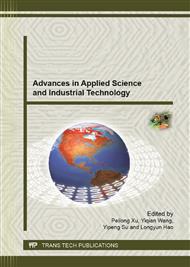[1]
Guo, X., Mroz, T.A., Popkin, B.M. and Zhai, F. Structural change in the impact of income on food consumption in China, 1989–1993[J]. Economic Development and Cultural Change 2000; 48: 737-760.
DOI: 10.1086/452475
Google Scholar
[2]
Wong, J.H. et al. Digestibility of protein and starch from sorghum (<i> Sorghum bicolor) is linked to biochemical and structural features of grain endosperm[J]. Journal of cereal science 2009; 49: 73-82.
DOI: 10.1016/j.jcs.2008.07.013
Google Scholar
[3]
Committee, A.A.O.C. Approved Methods of the American Association of Cereal Chemists.: AACC, (2000).
Google Scholar
[4]
Slinkard, K. and Singleton, V.L. Total phenol analysis: automation and comparison with manual methods[J]. American Journal of Enology and Viticulture 1977; 28: 49-55.
DOI: 10.5344/ajev.1977.28.1.49
Google Scholar
[5]
Engelsen, S.B., Jensen, M.K., Pedersen, H.T., Nørgaard, L. and Munck, L. NMR-baking and multivariate prediction of instrumental texture parameters in bread[J]. Journal of Cereal Science 2001; 33: 59-69.
DOI: 10.1006/jcrs.2000.0343
Google Scholar
[6]
Morad, M.M. and D Appolonia, B.L. Effect of surfactants and baking procedure on total water-solubles and soluble starch in bread crumb[J]. Cereal Chem 1980; 57: 141-144.
Google Scholar
[7]
Rindlav-Westling, Å., Stading, M. and Gatenholm, P. Crystallinity and morphology in films of starch, amylose and amylopectin blends[J]. Biomacromolecules 2002; 3: 84-91.
DOI: 10.1021/bm010114i
Google Scholar
[8]
Ribotta, P.D., León, A.E. and Añón, M.C. Effect of freezing and frozen storage on the gelatinization and retrogradation of amylopectin in dough baked in a differential scanning calorimeter[J]. Food Research International 2003; 36: 357-363.
DOI: 10.1016/s0963-9969(02)00227-2
Google Scholar
[9]
Sidhu, J.S., Seibel, W. and Meyer, D. Gelatinization of starch during preparation of Indian unleaved flat breads[J]. Starch‐Stärke 1990; 42: 336-341.
DOI: 10.1002/star.19900420904
Google Scholar
[10]
Slade, L., Levine, H. and Reid, D.S. Beyond water activity: recent advances based on an alternative approach to the assessment of food quality and safety[J]. Critical Reviews in Food Science & Nutrition 1991; 30: 115-360.
DOI: 10.1080/10408399109527543
Google Scholar
[11]
Baik, M.Y. and Chinachoti, P. Moisture redistribution and phase transitions during bread staling[J]. Cereal Chemistry 2000; 77: 484-488.
DOI: 10.1094/cchem.2000.77.4.484
Google Scholar


